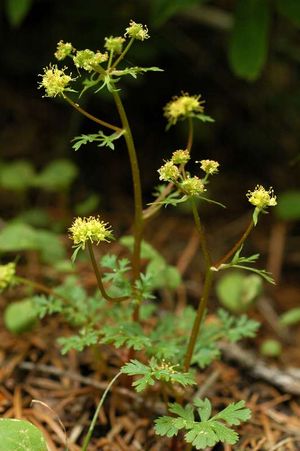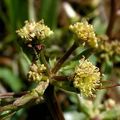Difference between revisions of "Sanicula graveolens"
(Created page with '==Taxonomy== ==Description== ==Bloom Period== ==Distribution== ==Habitat== ==Uses== ==Propagation== ==Photo Gallery== ==References==') |
(Tag: VisualEditor) |
||
| Line 1: | Line 1: | ||
| + | * Scientific Name: ''Sanicula graveolens'' | ||
| + | * Family: Apiaceae | ||
| + | * Common Names: Sierra sanicle, northern sanicle | ||
| + | * Previous Names/Misapplications: ''Sanicula septentrionalis, S. nevadensis, S. graveolens var. septentrionalis'' | ||
| + | * Codon: SANGRA | ||
| + | |||
| + | [[File:SAGR BenLegler veg good.jpg|thumb|photo by Ben Legler]] | ||
| + | |||
==Taxonomy== | ==Taxonomy== | ||
| + | {{Taxobox | ||
| + | | name = Sanicula graveolens | ||
| + | | regnum = [[Plant]]ae | ||
| + | | subregnum = Tracheobionta | ||
| + | | phylum = Spermatophyta | ||
| + | | subphylum= Magnoliophyta | ||
| + | | classis = Magnoliopsida | ||
| + | | subclassis = Asteranae | ||
| + | | ordo = Apiales | ||
| + | | familia = Apiaceae | ||
| + | | genus = '''''Sanicula''''' L. | ||
| + | | species = '''''Sanicula graveolens''''' Poepp. ex DC | ||
| + | | subspecies = | ||
| + | }} | ||
| + | |||
==Description== | ==Description== | ||
| + | Taprooted perennial. | ||
| + | |||
| + | The lowermost leaves often attached at or below the ground surface, ternate-pinnate, primary divisions are generally pinnatifid, the primary divisions separated from the other segments by an entire (not toothed) rachis. Upper cauline leaves less well developed and smaller. | ||
| + | |||
| + | Inflorescences are umbels made up of yellow flowers, staminate flowers more numberous than bisexual flowers. Terminal umbels are head-like, flowers nearly cessile, and umbels subtended by pointed bracts. Calyx connate at base, calyx teeth ovate and pointed. | ||
| + | |||
| + | Fruit is ovioid-globose, with uncinate prickles. <ref name=":0">WTU Herbarium, Burke Museum, | ||
| + | & University of Washington. Retrieved from <nowiki>https://biology.burke.washington.edu/herbarium/imagecollection/taxon.php?Taxon=Sanicula%20graveolens</nowiki></ref><ref name=":1">Hitchcock, C. L., Cronquist, A., Giblin, D., & Legler, | ||
| + | B. et al. (2018). ''Flora of the Pacific Northwest: an illustrated manual''. | ||
| + | Seattle: University of Washington Press.</ref> | ||
| + | |||
==Bloom Period== | ==Bloom Period== | ||
| + | May-July<ref name=":0" /> | ||
| + | |||
==Distribution== | ==Distribution== | ||
| + | Victoria Island and southern BC south, both sides of the Cascades, to southern California, east to western Montana and northwestern Wyoming.<ref name=":1" /> | ||
| + | |||
==Habitat== | ==Habitat== | ||
| + | Open slopes and flatlands, low to middle elevations.<ref name=":1" /> | ||
| + | |||
==Uses== | ==Uses== | ||
| − | = | + | There are many accounts of other ''Sanicula'' species used for both food and medicine.<ref>Native American Ethnobotany Database. Retrieved from <nowiki>http://naeb.brit.org/uses/search/?string=sanicula+</nowiki></ref> |
| + | |||
==Photo Gallery== | ==Photo Gallery== | ||
| + | <gallery> | ||
| + | File:SANGRA3.jpg|photo by Ben Legler | ||
| + | File:SANGRA4.jpg|photo by Ben Legler | ||
| + | File:SANGRA.jpg|seedling, courtesy CNLM | ||
| + | File:SANGRA1.jpg|young growth, courtesy CNLM | ||
| + | </gallery> | ||
| + | |||
==References== | ==References== | ||
Revision as of 00:25, 9 May 2020
- Scientific Name: Sanicula graveolens
- Family: Apiaceae
- Common Names: Sierra sanicle, northern sanicle
- Previous Names/Misapplications: Sanicula septentrionalis, S. nevadensis, S. graveolens var. septentrionalis
- Codon: SANGRA
Contents
Taxonomy
| Sanicula graveolens | |
|---|---|
| Scientific classification | |
| Kingdom: | Plantae |
| Subkingdom: | Tracheobionta |
| Phylum: | Spermatophyta |
| Subphylum: | Magnoliophyta |
| Class: | Magnoliopsida |
| Subclass: | Asteranae |
| Order: | Apiales |
| Family: | Apiaceae |
| Genus: | Sanicula L. |
| Species: | Sanicula graveolens Poepp. ex DC |
Description
Taprooted perennial.
The lowermost leaves often attached at or below the ground surface, ternate-pinnate, primary divisions are generally pinnatifid, the primary divisions separated from the other segments by an entire (not toothed) rachis. Upper cauline leaves less well developed and smaller.
Inflorescences are umbels made up of yellow flowers, staminate flowers more numberous than bisexual flowers. Terminal umbels are head-like, flowers nearly cessile, and umbels subtended by pointed bracts. Calyx connate at base, calyx teeth ovate and pointed.
Fruit is ovioid-globose, with uncinate prickles. [1][2]
Bloom Period
May-July[1]
Distribution
Victoria Island and southern BC south, both sides of the Cascades, to southern California, east to western Montana and northwestern Wyoming.[2]
Habitat
Open slopes and flatlands, low to middle elevations.[2]
Uses
There are many accounts of other Sanicula species used for both food and medicine.[3]
Photo Gallery
References
- ↑ 1.0 1.1 WTU Herbarium, Burke Museum, & University of Washington. Retrieved from https://biology.burke.washington.edu/herbarium/imagecollection/taxon.php?Taxon=Sanicula%20graveolens
- ↑ 2.0 2.1 2.2 Hitchcock, C. L., Cronquist, A., Giblin, D., & Legler, B. et al. (2018). Flora of the Pacific Northwest: an illustrated manual. Seattle: University of Washington Press.
- ↑ Native American Ethnobotany Database. Retrieved from http://naeb.brit.org/uses/search/?string=sanicula+





